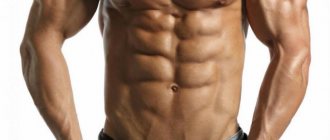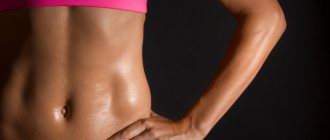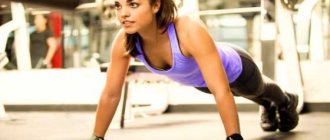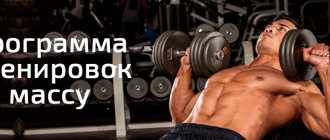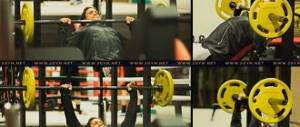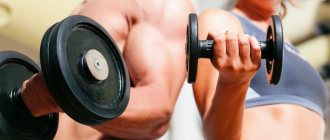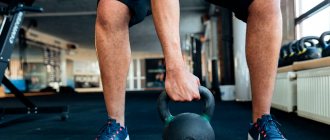Sculpted abs are the dream of many men and women, but how can you make your dream come true? Famous sports bloggers say: “Abs are made in the kitchen.” This means that not only training, but proper nutrition will create six-pack abs, because nutrition should be given more importance than pumping up muscles. We’ll find out further how to properly pump up your abs without leaving home.
Is it possible to pump up your abs at home without going to the gym?
Indeed, to see the cubes, you need to get rid of the fat layer and this is not so easy. You can perform a training complex for years, but still not see sculpted abs, but you can achieve good results in a month. Sweets, flour products and many other simple carbohydrates will cover the abdominal muscles with a layer of fat, and no matter how hard you train your abs, there will be no effect.
When training at home, you need to start by introducing proper and healthy foods into your regimen. Moreover, each product must be taken on time, without leading the body to starvation and without slowing down the metabolism.
Fortunately, you don't need any special machines or equipment to train. Classes can be done using your own weight. All you need is a mat; you can add, if desired, special weighted cuffs to increase the load and pump up your abs.
Since the body can get used to each load, it is necessary to use additional weights or the help of a partner to complicate the exercise. At home, you can use your imagination by taking bottles of water in your hands instead of dumbbells, and this will be very effective. Therefore, it is quite possible to do an abdominal workout at home without spending much time. But remember, the rest of the time is spent monitoring nutrition.
What does it take to see abs on your stomach?
In order to quickly pump up perfect abs, you must first of all get rid of excess fat. Abdominal muscles do not require enormous effort to improve the tone and shape of the cubes; they are already anatomically formed so that they can be viewed provided there is a complete absence of subcutaneous fat. Accordingly, the smaller the adipose tissue, the more prominent the cubes on the abdomen.
You can lose fat through exercise, but it should not be limited to abdominal exercises. To speed up the results, you need to perform cardio training, which stimulates overall fat burning, then fat will be lost evenly from the entire body. Training should be regular, but you shouldn’t do it every day.
The abdominal muscles recover quite quickly, so you can load them within a day. Abdominal exercises can be performed after cardio exercise. For example, after a 30-minute run, a complex for the press is performed. Another important condition for drawing cubes is the correct diet. Nutrition should not slow down the results. By fulfilling all the requirements, each week the cubes will be visible more clearly.
Are there any differences between women's ab workouts and men's?
The muscle structure of men and women is the same. Therefore, there is no difference in training for this group. Men have more strength, and more often than not, they want to have hard and voluminous abdominal muscles. This may be where the difference between training of different genders may appear.
A man can take a heavier weight and perform a set of 10–12 repetitions. A girl can also train, but she may not have enough strength for such training, but the essence is the same - abdominal training for men and women can be done the same. For some the results will be faster, for others it will take longer. For both, to burn fat in the abdominal area, you need to perform the exercise a large number of repetitions.
Anatomy of abdominal muscles
The group we are interested in, the one that forms the sculpted abs, is called the rectus abdominis muscle. It starts from the sternum, the anterior surface of the costal cartilages and passes downwards, attaching to the pubic bone. It is interrupted by tendon bridges, which form the abs. The muscle allows you to twist your back in the lumbar region.
The fibers of the external oblique muscle begin from the lateral surface of the chest, passing into the wide aponeurosis. Its fibers are located along an oblique line, passing from top to bottom in the direction of the external intercostal muscles. Its function is to rotate the chest in the opposite direction relative to the pelvis, as well as flex the spine during bilateral contraction.
Also, under the listed external muscles, there are deep ones: the transverse abdominal muscle and the internal oblique. They are stabilizers of the spine, fixing the stable and correct position of the lumbar region and pelvis.
What is a press?
It’s worth immediately touching on the myth of the lower, middle, upper press.
The rectus abdominis muscle is uniform and uniform along its entire length. And the cubes are nothing more than tendons that keep the internal organs from falling out. Their number and depth depend on genetics. There are athletes who have 8 or 10 cubes, and there are those whom nature has awarded only four. However, well-defined obliques and a flat navel will accentuate the waist of any athlete and give their figure an aesthetic appearance. The press is the center for issuing commands to the entire body. Any movement begins with the brain sending a command to the center of nerve signals (solar plexus). It is located in close proximity to the abdominal muscles, and the power of the impulse, which transmits the core of nerve signals to the muscle, depends on its condition and training. In other words, a weak center gives weak commands.
Posture is equally important. You need to keep your back straight in any position so that the body gets used to it and automatically puts the muscles in that position. Poor posture leads to a bulging abdomen or “sitting fold,” which persists even with a low percentage of fat. Moreover, in a standing position, the skin is more stretched and the cubes are seen better
How to remove excess fat and quickly pump up your abs?
Proper nutrition for cubes
The first thing you need to pay attention to is the contents of your daily diet and, in no case, ignore the importance of eating behavior. You can quickly tighten your stomach only by following a competent diet and choosing the right diet.
Start simple, remove all excess, namely:
- confectionery products (chocolate, candies, cakes, pastries);
- flour products: white bread, noodles, rolls, cookies, crackers;
- sugar and sugar substitutes;
- refined oils and fried foods;
- animal fat (lamb, pork, meat with skin);
- fruits, vegetables and dried fruits with a high glycemic index: grapes, dates, cranberries, pumpkin, watermelon, rutabaga, boiled carrots;
- carbonated drinks - cola, beer;
- products containing starch, potatoes in any form;
- limit the consumption of cereals that do not contain fiber: semolina, white rice, couscous, millet, pearl barley.
Instead, look for foods that are low on the glycemic index, low in calories, and low in fat and carbohydrates.
To draw cubes you need to use more:
- animal protein – lean meat (chicken, beef, turkey, rabbit), eggs;
- seafood: fish, squid, mussels, shrimp, mussels, octopus;
- fermented milk products with low fat content, but not low-fat: cottage cheese, feta cheese, tofu, kefir, yogurt, fermented baked milk, milk;
- vegetables containing fiber: white cabbage, cauliflower, broccoli, zucchini, cucumbers;
- fruits with low sugar content, but in the first half of the day - apples, oranges, grapefruits, pears, plums, apricots;
- cereals: brown rice (unpolished), buckwheat.
Nutrition before and after training
Training should begin no less than an hour and a half after eating. If you train in the afternoon or evening, with an emphasis on strength training, then it is permissible to eat complex carbohydrates along with protein, since the carbohydrates will be absorbed immediately. But don't overeat. If you exercise in the morning or afternoon, then consuming carbohydrates at lunch, after your workout, will be your last carbohydrate intake. The rest of the time you can consume proteins and vegetables. The main way to lose weight is to cut carbohydrates.
Menu example 1
- Breakfast: oatmeal with milk, one fruit;
- Training: drink 1 to 1.5 liters of water;
- Lunch (within 40 minutes after the end of the workout): buckwheat porridge, baked chicken fillet;
- Snack: egg and cottage cheese omelet, kefir;
- Dinner: fresh vegetable salad, lean meat or fish, steamed or in the oven without adding oil.
Menu example 2
- Breakfast: scrambled eggs, vegetables and herbs, whole grain bread or crispbread;
- Snack: one fruit or low-fat yogurt with cottage cheese;
- Lunch: fish or meat with stewed vegetables;
- Workout: 1 – 1.5 liters of water;
- Dinner: (within 40 minutes after training), brown rice with vegetables, eggs or cottage cheese.
You can also include a multivitamin complex and fish oil, more precisely polyunsaturated omega-3 fatty acids, in your diet. They will help burn belly fat, breaking it down to be used as an energy source during workouts.
The best abdominal exercises at home
When performing the exercise, try to include in the work exactly the area that you want to work. The neuromuscular connection plays an extremely important role when pumping up any muscle group. This will allow the necessary fibers to be included in the work as much as possible and make the movement more efficient.
Crunches
Various crunches are the most effective way to work the abdominal muscles, which contract directly when twisting the body.
Important! Do the exercises correctly! Raising the body should be performed only with a rounded back, lowering to the floor in turn with each part of the spine. And lower crunches (leg raises) on a bench or on the floor are performed only with the lower back tightly pressed to the floor, without bending. Both techniques will eliminate the possibility of injury to the lumbar spine.
However, exercises by themselves are ineffective if you do not perform fat-burning complexes and cardio exercises.
Run
This is an excellent and affordable way to combat excess fat. This type of cardio burns subcutaneous fat as energy necessary for work. By reducing waist size, running can gradually create a beautiful contour. But in addition to fat burning, it is necessary to tone the muscles, then the appearance of the abs will be more distinct and harmonious. The look of such a waist will be more sporty.
Circuit training
Another one of the most effective ways to form beautiful abs is circular fat-burning training. Their essence is to work out all muscle groups in a short time. Exercises should be performed without pause and involve as many muscles and joints as possible in one exercise. You can exercise with your own weight, without special equipment. Three lessons per week is enough. Naturally, the complex also includes abdominal exercises, which helps to quickly achieve results, both overall weight loss and muscle toning. Cardio exercises along with strength training are the most effective method of getting a beautiful belly.
A set of exercises for drying the press
From the anatomical structure it is clear that the rectus muscle is located along the entire length of the front of the body from the chest to the groin; it is a solid muscle that is divided by membranous tendons. When twisting, lifting, folding, the abdominal muscles work completely, and not its individual parts. The concept of the top and bottom of the press exists more as a measure of sensation in a certain area in a particular exercise. Muscle contractions are more noticeable in either the lower or upper part, depending on the exercise. But remember, in any case, the muscle is fully worked.
Upper abs exercises
Curling your torso on the floor
Lying on the floor, feet up, legs slightly bent at the knees. Hands behind your head, chin looking up, not pressing against your collarbones. As you exhale, the upper part of the body is folded, lifting only the shoulder blades, the lower back is pressed tightly to the floor. As we inhale, we return to lying on our shoulder blades. The exercise is performed dynamically, without pauses or breath holdings. Perform 20–30 times, 3–4 approaches.
Rolling up the torso with the lower leg on a bench
The shins are placed on the bench, forming a right angle at the knees. Lying with your back on the floor, press your lower back tightly to the floor. With your palms behind your head, as you exhale, we roll up the thoracic region, feeling a burning sensation in the upper part of the rectus muscle. The chin is not pressed against the collarbones, the gaze is directed to the ceiling. Exhale and lower your shoulder blades to the floor. Perform at a dynamic pace 20–30 times, 3–4 approaches.
Lower abs exercises
Lower crunches
Lying on the floor, palms under the buttocks. The lower back is pressed tightly to the floor. Legs together, raised perpendicular to the floor. As you inhale, lower your feet down without bending your lower back. Exhale – lower the abdomen and raise the legs up. Repeat 20–30 times, 3–4 approaches.
Short pelvic thrusts
Lying on the floor, legs together, raised perpendicular to the floor. Using quick and short movements with the lower part of the rectus muscle, we push the pelvis upward. By tearing off only the sacral section, the lower back remains on the floor. Perform 30–40 times, 3–4 approaches.
Exercises for obliques
Side crunches
Lying on the floor, right foot on the floor, bending the left knee, place the foot on the right knee. The right hand is behind the head, and the left is extended to the side, performing an emphasis. As we exhale, we twist diagonally, straining the oblique muscles, and with the elbow of our right hand we aim for the opposite knee. The lower back does not lift off the floor, only lifting the scapula; the chin does not fall toward the sternum. Perform 20 – 30 times.
Change position to the other side. Perform 20 – 30 times. After this, repeat 2 – 3 more approaches.
The structure of the abdominal muscles
First of all, you need to know that the abdominal press consists of several muscle groups.
- The rectus muscle is a long, flat muscle that is divided vertically into two parts by tendons. Connective fibers cross it across it, resulting in the formation of six zones, which with regular training turn into, as they are popularly called, “cubes”. The rectus abdominis muscle helps keep your back straight and is responsible for beautiful posture.
- The transverse abdominis muscle is located directly below the rectus muscle. It serves to maintain the internal organs in normal condition.
- The external obliques run diagonally from the lower abdomen to the chest. They are quite large and therefore clearly visible. The oblique muscles take part in the processes of flexion and rotation of the body.
- The internal oblique muscles of the abdomen are located deep under the external obliques. They are almost invisible, but also play a role in the formation of a beautiful relief of the abdominal muscles.
The best set of exercises for sculpted six-pack abs
This workout consists of seven carefully selected ab exercises to train at home, equally good for working both the upper and lower parts of the abdomen.
Like most people, you can train your abdominal muscles long and hard. But if you need to show six-pack abdominal muscles with a large percentage of subcutaneous fat, then you can’t do without a proper diet with a calorie deficit. If your goal is sculpted abs, you can’t do without proper training.
This training complex includes seven selected exercises to work the upper and lower abdominal muscles. Do it three times a week and, combined with proper nutrition, strength training and optimal cardio training, your abs will transform in no time.
3 circuits, minimal rest between exercises and 1-2 minute break between circuits
How to do this set of abdominal exercises
This is a workout for advanced athletes, so how you perform it plays a vital role.
For beginners, it is better to take no more than three exercises out of seven, doing two sets of each with a maximum number of repetitions and a minute pause between sets. Next, increase the duration of your workouts by adding exercises and sets and reducing rest time.
Your ultimate goal is, at the end of 12 weeks, to be able to complete all seven exercises in one long circuit without resting, rest for 1-2 minutes, and repeat twice more.
While you can’t do this yet, you can break the workout into parts as you wish. For example, I like to do the following supersets:
- Repeat three times:
- Exercises 1 and 2, 30 sec. respite
- Exercises 3 and 4, 30 sec. respite
- Exercises 5 and 6, 30 sec. respite
- Exercise 7, 30 sec. respite
Each superset continues until short-term muscle failure occurs, or until repetitions begin to be difficult.
You may have noticed that the routine does not directly engage the obliques. This is explained by the fact that in my experience, purposefully working these muscles only makes the waist wider. In addition, the oblique muscles are perfectly loaded during squats, deadlifts and other basic exercises with your own body weight.
How to build an ab workout
So, you know the basic rules, now let's see how best to build abs training. It's simple - you need to do circuit training, which consists of three exercises performed one after another. You will rest between circles and then repeat them.
Here's how circuit training should go:
- Do 1 set of weight-bearing exercises, such as crossover crunches, push-up leg raises, or hanging leg raises, for 10 to 15 reps. This means that if you can't do more than 10 reps, the weight is too heavy. But if you can do more than 15, it's time to add another 2 kg.
- Immediately perform any bodyweight exercise to failure.
- Without rest, do another bodyweight exercise to failure.
- Rest between circles – 2-3 minutes.
For example, here is my abdominal training program:
- 1 set of crossover crunches, 10-12 reps;
- 1 set of leg raises, to failure;
- 1 set of bicycle exercise, until failure.
- rest 2-3 min.
I usually do these circuits between sets of large muscle group exercises to save time. Eg:
- 1 deadlift approach;
- 1 circle for the press;
- rest 60-90 seconds;
- 1 deadlift approach;
- 1 circle for the press;
- rest 60-90 seconds.
And so on. I recommend doing 3 laps per workout (2-3 times a week) . As you'll see, it's harder than it looks!
When to train your abs
For most people, doing this routine at least three times a week will be enough. Advanced bodybuilders can do it every day.
Personally, I like to do abs and cardio first thing in the morning when I get out of bed, leaving strength training for the afternoon. This is how I speed up my metabolism as much as twice a day.
If you prefer to train everything in one fell swoop, I would recommend loading the abs as a warm-up before strength training or a cool-down after it if you are planning on heavy exercises like squats or deadlifts. And after that, go to cardio.
Rules for training the press
The rules for abdominal training are very simple.
Combine exercises with and without weights
Well-rounded abs require a lot more muscle development than most people realize. Alternating exercises with and without additional weight is the most effective way to do this.
Train your abs often
How often can you pump up your abs? The optimal frequency of training is the subject of endless debate, but in general, small muscle groups recover faster than larger muscle groups [6]. Heavy exercises like squats and deadlifts take longer to recover than isolation exercises like dumbbell curls or dumbbell lateral raises. I've found that abs (as well as calves, by the way) can be easily trained 2-3 times a week in addition to basic training. This is the optimal frequency that will not lead to overtraining. Of course, you shouldn't train your abs for three days in a row. There should be 1-2 days of rest between classes. Personally, my schedule is Monday, Wednesday and Friday with three basic workouts per week and Tuesday and Thursday if I train twice.
Progress in exercises
As in training any other muscle groups, your goal in training “cubes” is to gradually progress and improve. Add pounds when doing exercises with dumbbells (extra weight) and increase the number of repetitions when doing bodyweight workouts.
